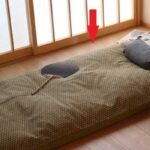Making the Most of Space
Japan, known for its high population density, especially in large cities, is famous for its small apartments and limited living space. To save space, the Japanese often use thin walls or sliding doors to divide different functional areas.
Living rooms are often transformed into bedrooms with just a tatami mat – a compact and multifunctional mat that maximizes space utilization.
Additionally, due to low ceiling heights in typical Japanese homes, using a bed could result in a person easily touching the ceiling when standing up. As a result, the Japanese have adapted by sleeping on the floor, creating a sense of spaciousness and making the ceiling appear higher.
Easier Earthquake Detection
According to JRAILPASS, Japan experiences approximately 1,500 earthquakes each year. Located at the intersection of two major tectonic plates, the country is frequently affected by both large and small earthquakes.
Sleeping on the floor allows the Japanese to quickly sense any ground movements and seek shelter promptly. Moreover, having minimal furniture makes evacuating safer and easier.
Cost-Effectiveness
Another reason why the Japanese forgo traditional beds is financial. Instead of investing in an expensive bed, they only need to purchase mats in the summer and blankets and futons in the winter. Besides the cost of buying a bed, there are additional expenses for maintenance and design, making mats and futons a more economical choice.
Safety for Children
When young children sleep on mats laid out on the floor, the risk of rolling out of bed or bumping into bed frames is minimized. Sleeping on the floor creates a safer sleeping environment for children, providing parents with greater peace of mind.
Health Benefits
Sleeping on a hard, flat surface can alleviate chronic back pain. On the other hand, a soft bed can sag over time, causing the spine to curve and leading to back pain. Sleeping on the floor helps maintain spine alignment and prevents the body from being forced into unnatural positions.
If you sleep in a correct posture on the floor and your spine is adequately supported, you’ll maintain a straight back throughout the day. Conversely, if the spine has to conform to a soft surface, sleep may negatively impact health and alter spine shape, resulting in stooping or hunching.
Additionally, sleeping on the floor improves blood circulation. Lying on your back prevents tingling and itching caused by poor blood flow. Sleeping curled up or prone on a mattress may restrict blood flow, causing numbness and itching in the hands and feet and potentially leading to cardiovascular issues.

Japan’s high population density, especially in large cities, presents challenges of limited living space.

Mats on the floor reduce the risk of children rolling out of bed or bumping into bed frames.
“The Surprising Benefits of Boiled Green Bananas”
Boiled green bananas are a humble yet powerful dish, offering a plethora of health benefits and a unique culinary experience. This understated fruit packs a nutritional punch, providing an array of vitamins and minerals that contribute to a healthy and balanced lifestyle. With its distinct flavor and texture, boiled green bananas take you on a journey to simpler times, evoking a sense of warmth and comfort with every bite.
The Surprising Reason Most Japanese People Choose to Sleep on the Floor Instead of in a Bed
The Japanese have a unique cultural practice of sleeping on the floor instead of in beds. This tradition has garnered intrigue and curiosity from the rest of the world, with many wondering why they opt for this seemingly uncomfortable sleeping arrangement. Unraveling this mystery reveals a deep-rooted connection to their cultural heritage and a myriad of surprising health benefits.






































